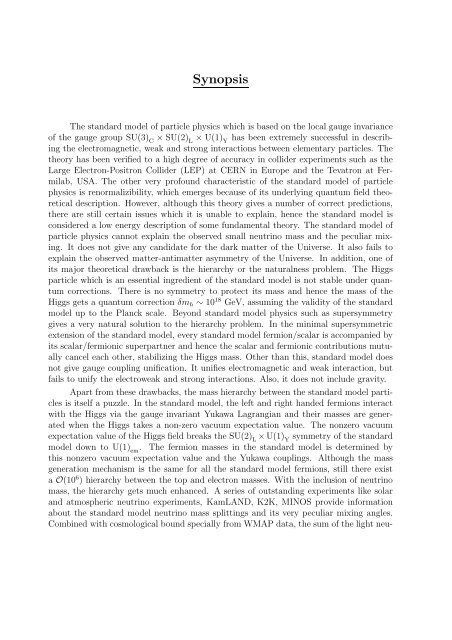PHYS08200604017 Manimala Mitra - Homi Bhabha National Institute
PHYS08200604017 Manimala Mitra - Homi Bhabha National Institute
PHYS08200604017 Manimala Mitra - Homi Bhabha National Institute
Create successful ePaper yourself
Turn your PDF publications into a flip-book with our unique Google optimized e-Paper software.
Synopsis<br />
The standard model of particle physics which is based on the local gauge invariance<br />
of the gauge group SU(3) C<br />
× SU(2) L<br />
× U(1) Y<br />
has been extremely successful in describing<br />
the electromagnetic, weak and strong interactions between elementary particles. The<br />
theory has been verified to a high degree of accuracy in collider experiments such as the<br />
Large Electron-Positron Collider (LEP) at CERN in Europe and the Tevatron at Fermilab,<br />
USA. The other very profound characteristic of the standard model of particle<br />
physics is renormalizibility, which emerges because of its underlying quantum field theoretical<br />
description. However, although this theory gives a number of correct predictions,<br />
there are still certain issues which it is unable to explain, hence the standard model is<br />
considered a low energy description of some fundamental theory. The standard model of<br />
particle physics cannot explain the observed small neutrino mass and the peculiar mixing.<br />
It does not give any candidate for the dark matter of the Universe. It also fails to<br />
explain the observed matter-antimatter asymmetry of the Universe. In addition, one of<br />
its major theoretical drawback is the hierarchy or the naturalness problem. The Higgs<br />
particle which is an essential ingredient of the standard model is not stable under quantum<br />
corrections. There is no symmetry to protect its mass and hence the mass of the<br />
Higgs gets a quantum correction δm h ∼ 10 18 GeV, assuming the validity of the standard<br />
model up to the Planck scale. Beyond standard model physics such as supersymmetry<br />
gives a very natural solution to the hierarchy problem. In the minimal supersymmetric<br />
extension of the standard model, every standard model fermion/scalar is accompanied by<br />
its scalar/fermionic superpartner and hence the scalar and fermionic contributions mutually<br />
cancel each other, stabilizing the Higgs mass. Other than this, standard model does<br />
not give gauge coupling unification. It unifies electromagnetic and weak interaction, but<br />
fails to unify the electroweak and strong interactions. Also, it does not include gravity.<br />
Apart from these drawbacks, the mass hierarchy between the standard model particles<br />
is itself a puzzle. In the standard model, the left and right handed fermions interact<br />
with the Higgs via the gauge invariant Yukawa Lagrangian and their masses are generated<br />
when the Higgs takes a non-zero vacuum expectation value. The nonzero vacuum<br />
expectation value of the Higgs field breaks the SU(2) L<br />
×U(1) Y<br />
symmetry of the standard<br />
model down to U(1) em<br />
. The fermion masses in the standard model is determined by<br />
this nonzero vacuum expectation value and the Yukawa couplings. Although the mass<br />
generation mechanism is the same for all the standard model fermions, still there exist<br />
a O(10 6 ) hierarchy between the top and electron masses. With the inclusion of neutrino<br />
mass, the hierarchy gets much enhanced. A series of outstanding experiments like solar<br />
and atmospheric neutrino experiments, KamLAND, K2K, MINOS provide information<br />
about the standard model neutrino mass splittings and its very peculiar mixing angles.<br />
Combined with cosmological bound specially from WMAP data, the sum of the light neu-
















